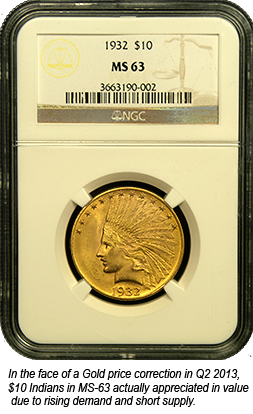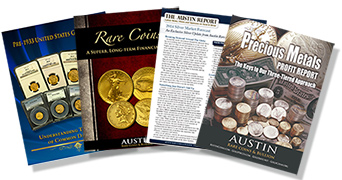Common Date Gold Coins vs Rare Coins

What’s the Difference?
At times, Austin Rare Coins & Bullion will recommend clients purchase Pre-1933 common date gold coins when we feel certain issues are temporarily undervalued in the marketplace. But, what exactly is a common date gold coin, and what is the difference between that and a rare coin? In the rare coin market, there are scarce coins and there are fundamentally rare coins.
What is a Rare Coin?
An example of a fundamentally rare coin is an 1859 New Orleans $10 Liberty Head. Only 2,300 were struck and fewer than 60 are known to exist in all grades that have been certified by PCGS and NGC over the past 25 years. Today, the finest known in the series would sell in excess of $70,000. (But you could never get the present owner to sell – we know. We sold him the coin.)
Yes, this is an extremely rare coin and perhaps a price tag that scares away some people. Coin dealers refer to this as a Classic Rarity – a coin that is fundamentally rare in all regards.
What is a Common Date Gold Coin?
Common date gold coins are less rare and very affordable. Common date pre-1933 U.S. coins are more available within a series and have a higher surviving number. They can be quite affordable, even those preserved in brilliant uncirculated, mint state grades. An example is the 1932 $10 Indian with a mintage of just over four million coins. The majority of these don’t exist today, but there are around 90,000 that have been certified in MS-63. This allows these half ounce coins to have the perfect balance of scarcity, affordability, and quality. With price ranges typically between $600 up to $2,500 per coin, this market offers an excellent bridge between gold bullion and truly rare coins.
If you believe that current prices offer a fantastic opportunity to start or add to your positions, then you should consider this area of the market. Certified Pre-1933 U.S. gold offers rarity, a high gold content, and appears to be oversold at today’s levels when compared to prices over the past several years.
While we don’t advise focusing solely on common-date material, the fact is they often add leverage in a rising gold market and the possibility to gain even when gold is falling. This is an important point to understand when building a balanced and diversified metals portfolio. The key is working with a knowledgeable firm who understands and realizes the best opportunities, and when to take advantage of them.
With a universal process and standards in place, these coins are extremely liquid and heavily traded each day across the industry. This system has created a healthy exchange market that is liquid, transparent, and reliable. We’re constantly evaluating this area and our top recommendations are based on the most attractive values and long-term potential.
Excellent Fundamentals
To summarize, here are the main reasons you should consider common-date gold:
- Diversification: A critical strategy for most investors, it makes good sense to spread your exposure across market segments to reduce risks and increase the strength of your portfolio as well as potential for profits.
- Fixed and Limited Supply: Because no more will be produced, they can rise in value quickly when demand overwhelms supply.
- Twice the Demand: Pre-1933 U.S. gold coins are in demand by both collectors and investors with new buyers from both categories consistently entering the market.
- A Younger Bull Market: As in the past, the modern bullion market is leading all metals segments in this long-term bull trend with many successful years ahead. Common-date gold is riding the same wave, but we’re convinced it’s at a younger stage in the cycle behind bullion. The way we see it, this segment offers a way to “buy gold at yesterday’s prices” and profit as the gap closes in the future.
- Solid Value at Current Levels: No one is certain what the future holds, but, as with stocks, a critical strategy in acquiring common-date gold is value. We only recommend coins that we’re convinced offer not only excellent long-term upside potential to their previous all-time highs, but also look undervalued in today’s changing marketplace.
Safety from Confiscation
It’s impossible to say how likely such action is or exactly how it would be executed. However, we believe that Pre-1933 U.S. gold coins have the best chance of being exempt from confiscation due to their track record and the fact that they’re valued above their gold content. Therefore, Pre-1933 U.S. gold adds a greater insurance policy to your bullion as well as better upside potential.
How to Get Started Today

Call Us at 1-800-928-6468
Let our team of Austin Advisors answer all your questions. We can guide you into the best private, non-reportable hard assets to meet your needs and budget.




